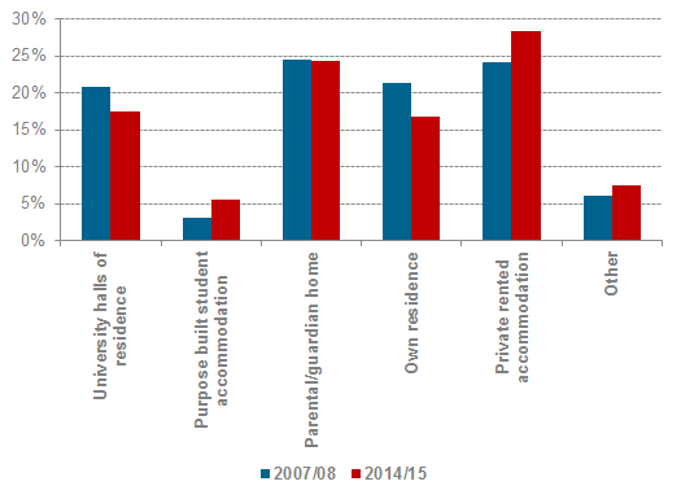Looking around my home City of Newcastle, it is clear that the student housing market has moved on considerably since I started university almost 12 years ago. Where once, the choice was simply between university halls of residence (if you could get a place) or the private rental market, a much wider range of options is now emerging in many cities, including an increasing volume of privately-operated purpose built student accommodation (PBSA).
These changes in the student accommodation market have emerged within the context of a booming student population. Over the past 15 years, full time higher education (HE) student numbers have increased by 1.46 million across the UK, including 620,000 additional international students.
The private rental sector has become increasingly important in accommodating UK students, providing a home for 28% of full-time students in 2014/15, compared to 24% in 2007/08. This represents a growth of almost 105,000 additional students in private rental accommodation. However, this isn’t always an ideal solution, with new student populations expanding into and displacing existing residential communities, and replacing those communities with a more transient population, potentially with social, economic and environmental consequences – and adding further pressure to an often already over-heated rental housing market.
PBSA has also grown significantly over the same period, albeit from a much lower base, providing homes for 6% of students in 2014/15, compared to 3% in 2007/08. If this rate of growth continues, PBSA could have a 10% share of the student accommodation within a decade. This growth in PBSA reflects both an increasingly competitive marketplace, and the fact that students are demanding more from their university experience, often seeking higher quality accommodation, inclusive of bills, internet connectivity and professional management.
Whilst increasing numbers of students are widely recognised as generating a broad range of economic benefits, they also bring a challenge for both local authorities and HE providers in planning for student accommodation.
The importance of providing sufficient accommodation for all students is recognised in planning policy and guidance. Indeed the Planning Practice Guidance in England specifically acknowledges the potential benefits of PBSA:
“Local planning authorities should plan for sufficient student accommodation whether it consists of communal halls of residence or self-contained dwellings, and whether or not it is on campus. Student housing provided by private landlords is often a lower-cost form of housing. Encouraging more dedicated student accommodation may provide low cost housing that takes pressure off the private rented sector and increases the overall housing stock.” “Plan makers are encouraged to consider options which would support both the needs of the student population as well as local residents before imposing caps or restrictions on students living outside of university-provided accommodation.” However, predicting future student numbers and the proportion of students requiring housing is challenging for both local authorities and HE providers, particularly in light of a recent drive in student recruitment following the reduction in public funding for universities.
NLP’s
BeDSPACE model provides a solution to this challenge, assessing the need and capacity for student accommodation within a user defined area. BeDSPACE analysis can be used as evidence to inform emerging local policy, business planning, or to support planning applications for new student accommodation.




